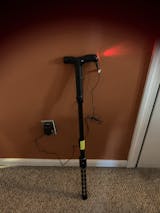DUCK CALLS
Duck hunting without a duck call? Well maybe, if you climb into your blind and discover that after giving your calls a good tuneup last night, you inadvertently left them on the coffee table. But otherwise, no way. Perhaps that is because, of all the game calls available, the duck call is perhaps the most effective in the field.
For most hunters calling ducks is by far the best part of duck hunting. For many it ranks as high as handling a good retriever dog. And the best duck call, well that, as the number of call manufactures would indicate, is debatable. This hunter has access to duck calls made by numerous manufacturers. Calls that cost less that a box of shells or calls that would set you back by twice as much a a case of shells. And, I have tried many models (but I do not recall using a duck call that I paid in excess of $25). Thanks to an ole high school/college buddy, I am now using the same call that I used in high school. But this is not a stock call, it has been modified by aforementioned fellow that performs a little magic and makes a really good duck call an awesome duck call. It wouldn't be easy for me to modify a $200 duck call. My frugal, thrifty nature just would not let me do it or perhaps I realize I do not have the skills and hearing that my hunting buddy has. But I encourage you to experiment with your calls. Try changing reed length, barrel diameter, retainer material, barrel length and so on. Practice and tinkering will make you a better duck caller.
How to call ducks. If your a confident, accomplished duck caller, please ignore this last paragraph. Here are a few basic suggestions for the beginner. First, do not blow air from your lungs - push the air out of your lungs in blast using the diaphram. Every "quack" sound can be made using the word FOOT. The T shuts the air off to help create a crisp quack. Here are 3 basic calls and when I generally use them. 1. Attention duck call: This call, sometimes know as the high ball, is a long series of quacks. Start with loud and long duration quacks and reduce the volume and duration of each successive quack. In foots it might look like FOOOOOOT, FOOOOOT, FOOOOT, FOOOT, FOOot, FOot, Foot, foot and so on. The series may be 15 to 18 quacks. Use this call to get the attention of ducks passing in the far distance. I never use this call when ducks are comely toward me are showing an interest in my immediate area. 2. Come Back Call: The comeback call is just what the name implies. Ducks that come near or show some interest in your location but continue or drift or pass by need the comeback call. This call is about 6 quacks. The initial quack is a loud, sharp quack followed by a louder quack with about twice to 2 1/2 times the duration of the first quack. These 2 quacks are followed by 4 to 5 quacks that begin with about the same volume and duration of the first but continue with progressively less volume and about the same duration. Once the ducks turn back toward you, you will want to use call number 3. But, the moment they drift or turn away, hit em with another comeback. And last, 3. Feed Call or Chatter. The actual feed call is actually the soft quacky chatter that ducks make when they are feeding in frenzied, excitement. I make this sound be blowing the words cutty-cutty-cutty into the call. Long strings of cutty-cutty with varying volume and intensity. More volume initially and softer as the ducks close range. I like to breakup my feed with single quacks FOOT. Again these single quacks are less volume and softer than those in call 1 and 2. And, once the ducks have locked em up and are gliding toward the decoys, I finish with soft single quacks until I raise the gun. I hope this helps. Worked and still works for me.
So get a duck call of your choice. Learn some duck sounds and experience the thrill of call decks right to your toes.














































































